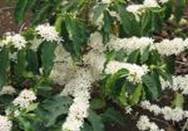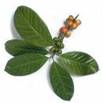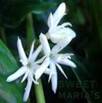| Kingdom | Plantae |
| Unranked | Angiosperms |
| Unranked | Eudicots |
| Order | Gentianales |
| Family | Rubiaceae |
| Genus | Coffea |
| Species | C. arabica |
| Binomial name | Coffea arabica |
Other Common Names:
The other common names for the tree are conker tree, Spanish chestnut, bongay, Chestnut, robkastanie, marronier d'Inde and buckeyes.
History
The name Coffee is derived from Caffa, a province of Abyssinia.The botanical name of the coffee tree is "coffea arabica," Arabia is not the indigenous home of coffee. The primeval habitat of the coffee tree is supposed to be Abyssinia, in which country it is still found wild. Coffee is also supposed to have been used from a most remote period as a beverage in Abyssinia.

Description
A small, evergreen tree, reaching 30 ft in the wild, but generally maintained 6-8 ft in cultivation. Leaves are ovate, 3-8" long, dark green, prominently veined with interveinal areas raised, waxy and smooth with entire margins. Leaves are arranged oppositely on stems and decussate, with successive pairs of leaves arising at 90° angles from each other around the stem. Leaves live about 1-2 years. Flowers are white, fragrant, ½ - 1" across, with 5 linear petals fused into a slender tube at their base. The ovary is inferior, bicarpellate, and capable of producing 2 seeds.


Range
Formerly endemic to the south-western forests of Ethiopia Coffea arabica has spread through the trade routes firstly to southern Arabia and from there it was taken to the East Indies by Dutch traders in the 17th century. It is now planted throughout the tropics, but particularly in East and West Africa, Central and South America, the West Indies, Asia, and Oceania.
Habitat
The coffee tree requires a mean temperature of 66-77 degrees Fahrenheit. Thus, the coffee tree is a tropical plant. The coffee plant cannot stand frost but does not die from an occasional cold night. It needs lots of water, requiring annual rainfall of 59 inches. Coffee plantations are normally situated in the altitude range of 984-6562 feet around the Equator. The best Arabica coffees are generally grown at altitudes greater than 3500 feet.
Cultivation
Depending on the size of the seed you may have to create a seed 'trench' or punch a row of small holes with a dibble stick. The rows should be at least an inch apart. The planting depth is critical but is usually one or two times the diameter of the seed. Carefully distribute your seeds onto the medium or into the small holes, using care to be sure that they are not crowded. This will ensure room for growth as well as good light and air circulation to the seedlings as they develop. Now you should create a miniature greenhouse environment for the pots or flats. Doing this will almost eliminate the necessity of watering the bed again before the seeds germinate.
Place your flat in an area where it will get good light but not direct sun, and stay as close to the desired temperature as possible. Germination can take anywhere from a few days to a couple of months, depending on what you are growing, so patience will have to be on of your virtues. Once the seeds have poked their little heads up, remove the green housing and move the flat gradually into brighter light or sun. At this stage, the seedlings have underdeveloped root systems, so watering is critical (check daily). The potting medium must remain moist, but never wet or soggy, because this will prevent oxygen to the roots and drown the new plants. When the plants have reached about 3 inches you can begin to water and feed the plants from above. When the plants have developed 4 true leaves, it time to thin and transplant them into pots. Seedlings growing in a tray should be thinned to one inch or more apart, where they may remain until they are ready to be planted in their permanent home. Move the plant to the new pot, gently dropping the roots into a pencil size hole which you have ready. Gently press the medium around the roots.
It is normal for a certain amount of wilting to occur after transplanting, due to some root damage and general plant shock. The plants should recover quickly. Keep the plants in good light for several days but not full sun. Gradually increase the light intensity. If the plants begin to get tall and spindly, they are not getting enough light and should be moved to a brighter spot. Water when necessary to prevent wilting. The final step is hardening off or acclimatizing the plants to the outdoor world. During this process make certain that the plants are kept well watered. Move your trays or pots of plants outdoors to a shaded, sheltered area. When the temperature drops at night, bring them back indoors. After doing this for 2-3 days put them into an area where they will receive a half day of sun (again, bring them in at night if it is expected to get cold), and 2-3 days later let them have full sun. After this hardening period they are ready to plant into their permanent position in the garden.
Flowering Season
Flowering of this Coffee profusely after rains, some coffee trees are found with flowers at all times of the year.
Pests and Diseases
Coffea arabica is a delicate plant which is plagued by more than 40 diseases caused by fungi, viruses, bacteria, and soil deficiencies. The worst disease is leaf rust caused by the fungus Hemileia vastatrix. The leaves die and drop off, and after a few years the bush dies. Leaf rust damage is a problem almost everywhere except in Central and South America, where farmers destroy the plants at the first sign of the disease. This success in fighting leaf rust explains why most Arabica coffee is grown there. Other, less serious diseases do occur, but mostly where growing conditions are marginal.
Parts Used


The coffee beans and the bark are the most commonly used parts of the tree for its commercial and medicinal value.
Medicinal Applications

• In the green pharmacy Coffee is used in the treatment of flu, asthma, pulmonary problems, and fainting. Also a brew is made from both the leaves and the beans and drunk to accelerate labour.
• Source of caffeine, dried ripe seeds are used as a stimulant, nervine, and diuretic, acting on central nervous system, kidneys, heart, and muscles.
• Coffee accelerates the heart, increases blood flow, and encourages breathing.
• Theobromine and theophylline in coffee help expand lung passages and inhibit bronchospasms.
• Coffee enemas effectively cleanse the large bowel.
• Coffee can help in headaches and migraine.
• In Ayurvedic medicine, the unripe beans are used for headaches, and the ripe, roasted beans for diarrhea.
Commercial Applications

• In its native Ethiopia, used as a masticatory since ancient times, it is also cooked in butter to make rich flat cakes.
• In Arabia a fermented drink from the pulp is consumed.
• Coffee is mainly used as a beverage.
• Coffee is widely used as a flavouring, as in ice cream, pastries, candies, and liqueurs.
• Indonesians and Malaysians prepare an infusion from dried leaves.
• Coffee pulp and parchment used as manures and mulches, and is occasionally fed to cattle in India.
• Coffelite, a type of plastic, made from coffee beans. Wood is hard, dense, and durable, takes a good polish, and is suitable for tables, chairs, and turnery. Coffee with iodine is used as a deodorant.
• Caffeine has been described as a natural herbicide, selectively inhibiting germination of seeds of Amaranthus spinosus.

By the 13th century, Coffee's restorative powers were well known in the Islamic world. Coffee was considered a potent medicine, as well as a religious potion that helped keep people wake during prayers. Coffee was initially used for spiritual reasons in Africa and Yemen. Its early association in Europe with rebellious political activities led to its banning in England, among other places. Coffee continues to play an important role in the social life of many communities. It is also one of the world's largest, most valuable, legally traded commodities.
The first coffee house in London was opened in 1652 by a servant of Edwards. According to one story, a goat-herder noticed that his herd became friskier than usual after consuming the red cherries of a wild coffee shrub. Curious, he tasted the fruit himself. He was delighted by its invigorating effects, and was even spotted by a group of nearby monks dancing with his goats.
Soon the monks began to boil the bean themselves and use the liquid to stay awake during all-night ceremonies. The other story is about a Muslim dervish who was condemned by his enemies to wander in the desert and eventually die of starvation. In his delirium, the young man heard a voice instructing him to eat the fruit from a nearby coffee tree. Confused, the dervish tried to soften the beans in water, and when this failed, he simply drank the liquid. Interpreting his survival and energy as a sign of God, he returned to his people, spreading the faith and the recipe.